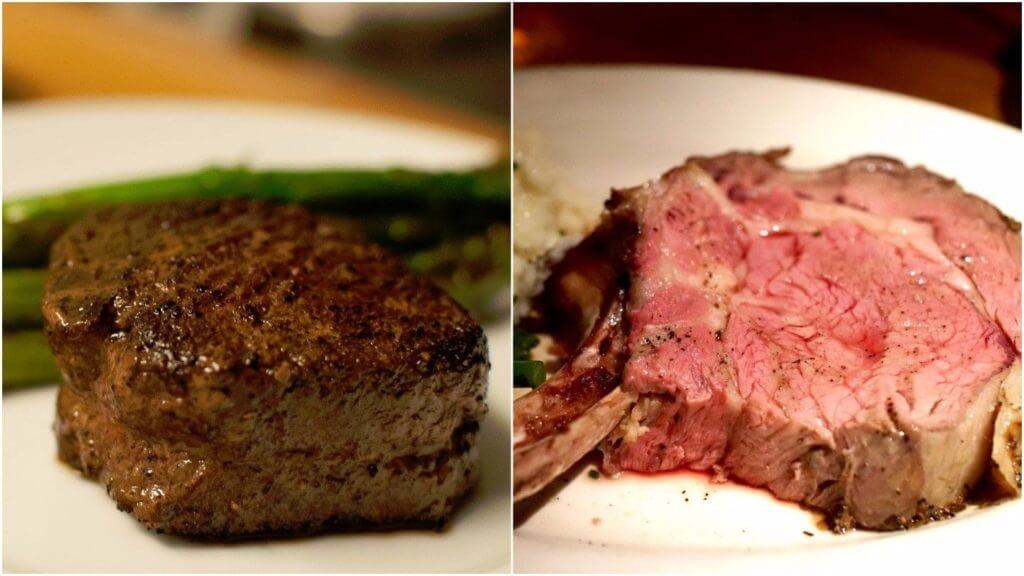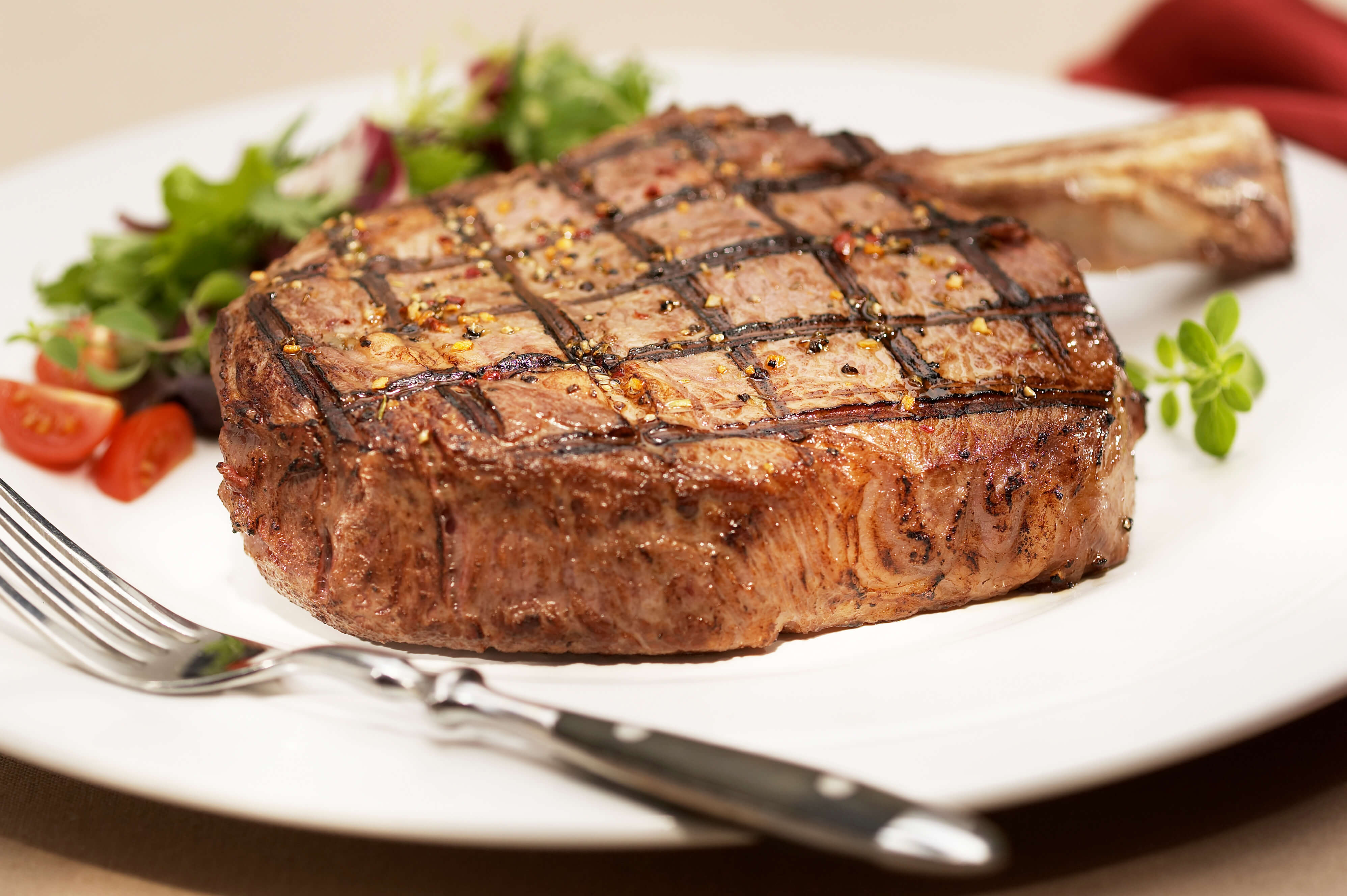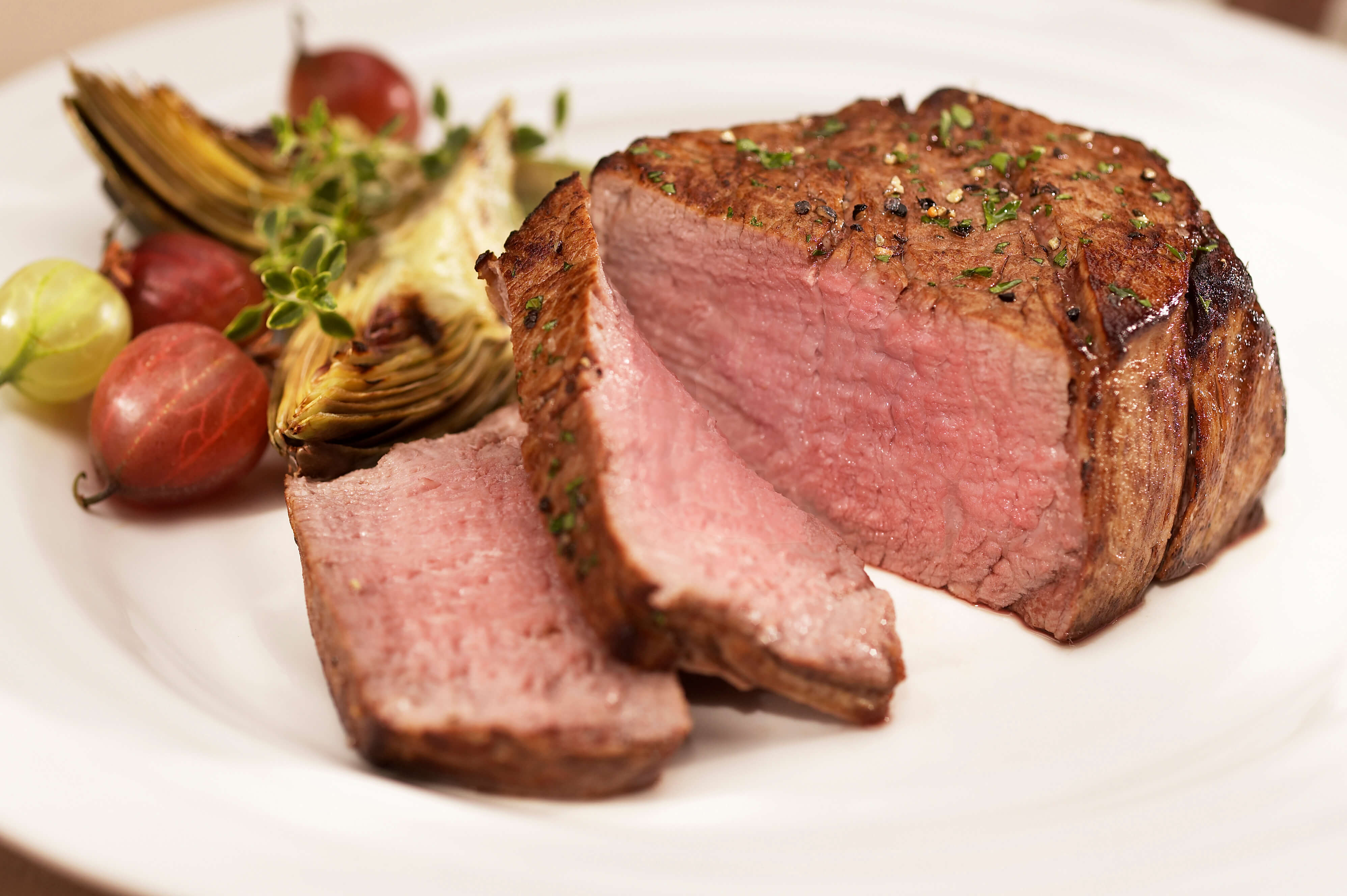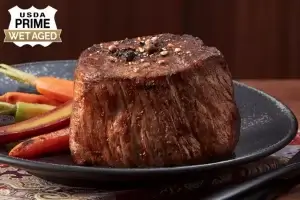
Credits: Robspinella via Wikimedia Commons and Jun Seita via Flickr
One of the most pressing questions for any steak lover: What’s better? Prime rib or filet mignon? Our answer: They’re both amazing cuts that are sure to delight you and your steak-loving guests. So, while we, at Steak University, suggest that you test out the best steak cuts for yourself to find out which ones you prefer, we are also happy to help you learn the differences because the flavor isn’t the only factor to consider. You also want a steak that cooks the way you want it to, has the texture you love, and stays within your budget. Both the prime rib and filet mignon have a lot to offer, so let’s get down to business.
Two of the Best Types of Steak: The Prime Rib and Filet Mignon
Prime rib and filet mignon are both considered upscale choices of steak cuts and are frequently noted as two of the top 10 cuts of steak. But, filet mignon is often the type you’d see served at a fancy wedding, while prime rib is one you’d expect to see served at your favorite steakhouse. Choosing the best one usually depends on the occasion you’ll use it for.
All About the Prime Rib
People often confuse prime rib and ribeye. They both come from the rib area of the animal and are technically the same cut of steak. But, the ribeye refers to the cut before it’s cooked and the prime rib refers to the cut after it’s cooked, which is usually roasted in its own juices. Typically, prime rib isn’t cut from a rib roast until after the roast has been cooked. 
If you compare prime rib vs sirloin, T-bone, or porterhouse steaks, the rib roast often wins. Steak lovers obsess over a tasty ribeye or rib roast cut because they’re not only tender, but also deliver the rich steak flavor that steak enthusiasts love.
All About the Filet Mignon
So, prime rib (or ribeye) vs filet mignon? In terms of tenderness, filet will often beat out just about any other steak cut you pit it against. What cut is the filet mignon? The small, but thick, steak is cut right from the most tender part of the animal: the tenderloin. When cooked to medium rare, its tenderness needs no explanation. Most people describe its texture as one that melts in your mouth. 
But, when comparing a filet mignon to the prime rib steak, you might be disappointed in the flavor. While some steak lovers prefer a steak’s tenderness over flavor, others care more about the steak flavor than anything. The filet doesn’t bring the robust taste to your palate that prime rib does. Those expecting more of a steak flavor from this cut will likely be disappointed. That’s why you’ll usually see filet mignon served wrapped in bacon, with gravy, or with juices for a little added flavor.
Cost Differences in Cuts of Steak
What’s the best steak for your budget? At Steak U, we don’t like to put a price tag on delicious steak, but we know that cost is important. These two steaks are both high up on the price list because they’re desirable and revered as two of the best types of steak cuts.
But, filet mignon is one of the most expensive cuts and is usually several more dollars per pound than a prime rib or ribeye. Why is filet mignon expensive? The filet mignon section of the animal is much more limited than the rib area that prime rib is cut from, so the rarer cut will cost you more.
What is the Best Type of Steak to Grill?
Marbled steak cuts, like the prime rib, need some extra vigilance when cooking on the grill because their fat content can cause flare ups. But, if you exercise caution, the rib roast cooks beautifully on the grill. For added safety, consider using a drip pan underneath your rib roast to catch drippings. Since the rib roast does best when cooked slowly, this method also helps it cook indirectly away from the grill flames for a smoky, slow roast. Make sure you season your roast before you start cooking it, turn it throughout the grilling process to get an even cook, and remove it when the temperature reads a little under your optimal temperature. Medium rare is typically the desired temperate for prime rib, but since the roast will continue to cook after removed from the heat source it’s best to have a meat thermometer to check the internal temperature. Remove the roast around 115-120° F and allow it to rest for 5 to 10 minutes to reach your desired cook.
What Type of Steak is the Best for Pan Frying?
The filet mignon is the perfect cut to pan sear or fry. It’s best served medium rare, and it usually takes only a couple of minutes on each side to give it a good sear. Fry it up in a cast iron skillet with a little bit of olive oil or butter and salt and pepper to taste. You can even use the leftover juices to pour over your steak once it’s ready to serve.
You can pan sear a rib roast, too, before you finish cooking it with a roasting process. But, generally, the term “prime rib” refers to the ribeye that’s been roasted as a rib roast and cut from that section.
Our Final Say: Is Filet Mignon or Prime Rib the Finest Cut of Steak?
The filet mignon cut from a cow is, undoubtedly, the most tender cut of steak you’ll have. The cut from a rib roast is one of the most flavorful, thanks to incredible marbling that allows its fat to give it a taste and tenderness boost naturally. The filet is considered a fancier, more delicate cut. It’s perfect for weddings, banquets, and other important occasions. The prime rib is perfect for a weekend grilling session or a stuff-your-face steakhouse trip. Check out Chicago Steak Company’s USDA Prime Wet Aged Filet Mignon and Boneless Ribeyes, which will each give you a one-of-a-kind steak experience you won’t forget.
Prime Rib or Filet Mignon FAQs
Prime rib and filet mignon are both considered upscale choices of steak cuts and are frequently noted as two of the top 10 cuts of steak. Choosing the best one usually depends on the occasion you’ll use it for. Steak lovers obsess over a tasty ribeye or rib roast cut because they’re not only tender, but also deliver the rich steak flavor that steak enthusiasts love. A ribeye and prime rib are often confused, but the ribeye is the name give to the steak before it is cooked, and prime rib refers to the meat cut right from the rib roast after being cooked. In terms of tenderness, the filet will often beat out just about any other steak cut you pit it against. The small, but thick steak is cut right from the most tender part of the animal: the tenderloin. When cooked to medium rare, its tenderness needs no explanation. In terms of flavor, the filet mignon may fall short when compared with the prime rib steak. That’s why you’ll usually see filet mignon served wrapped in bacon, with gravy, or with juices for a little added flavor. Cost Differences in Cuts of Steak The filet mignon is one of the most expensive cuts and is usually several more dollars per pound than a prime rib or ribeye. The filet mignon is cut from a more limited area of the cow than the rib area that prime rib is cut from, so the rarer cut will cost you more. Grill or Pan Fry? If you exercise caution (higher fat content may result in flare ups on grill), the rib roast cooks beautifully on the grill. The rib roast does best when cooked slowly and to medium rare. The filet mignon is the perfect cut to pan sear or fry. It’s best served medium rare, and it usually takes only a couple of minutes on each side to give it a good sear.


